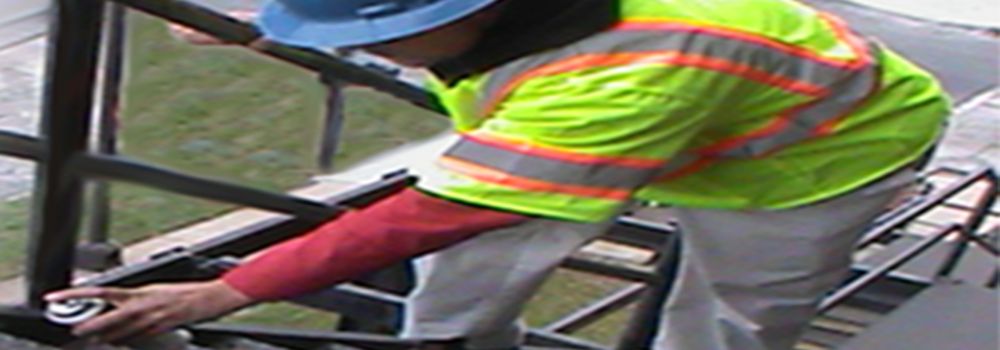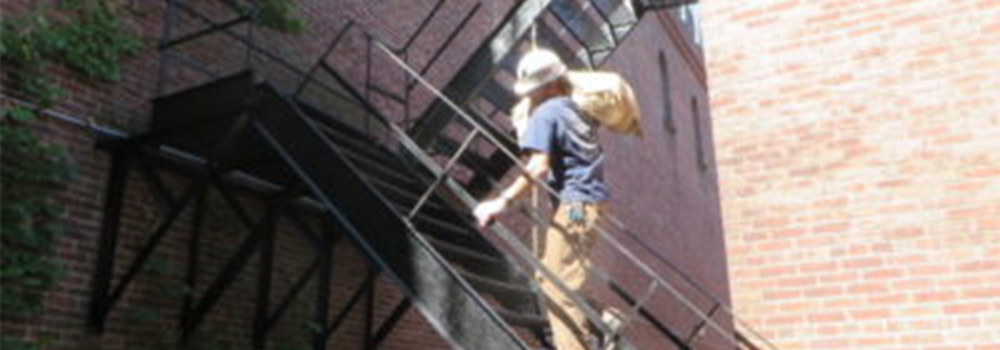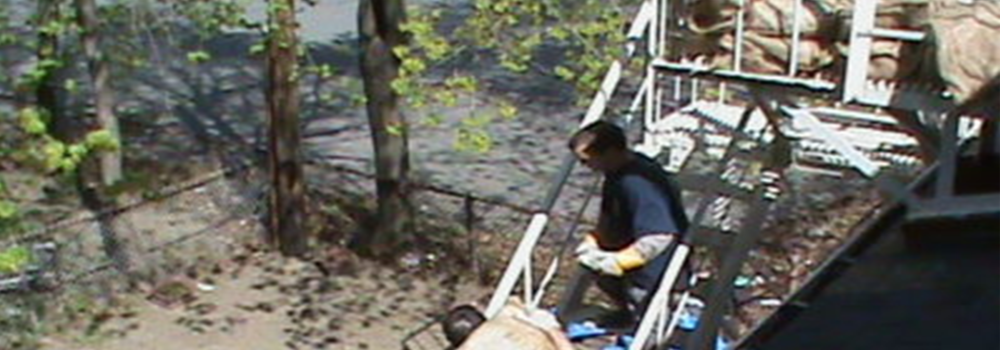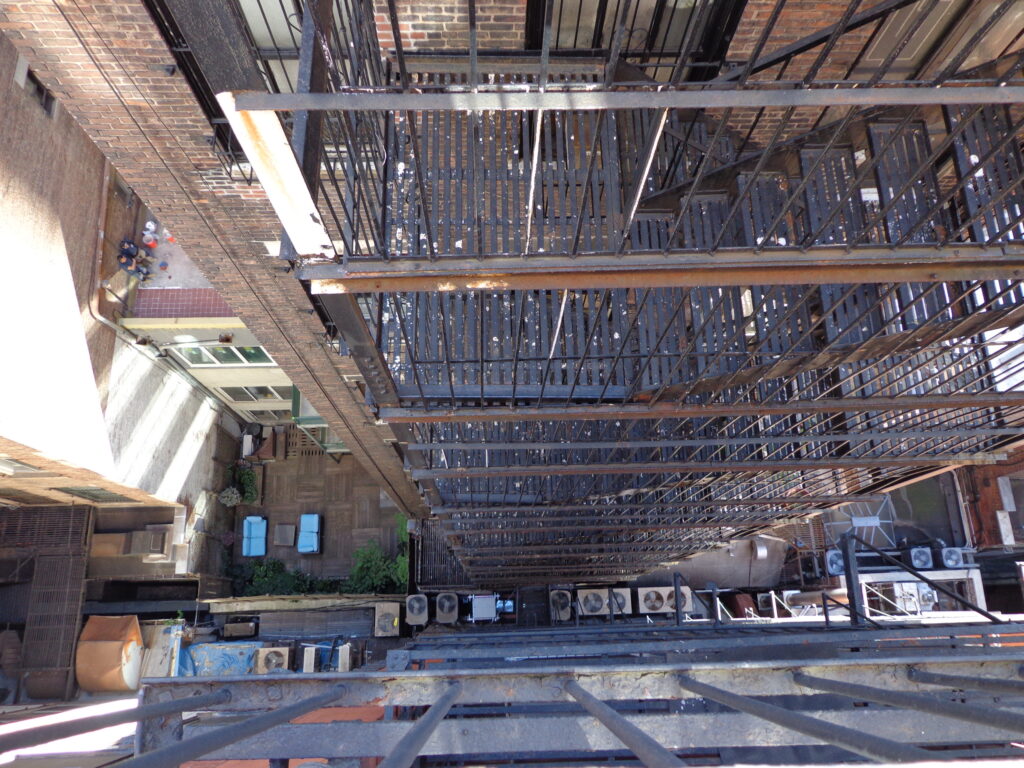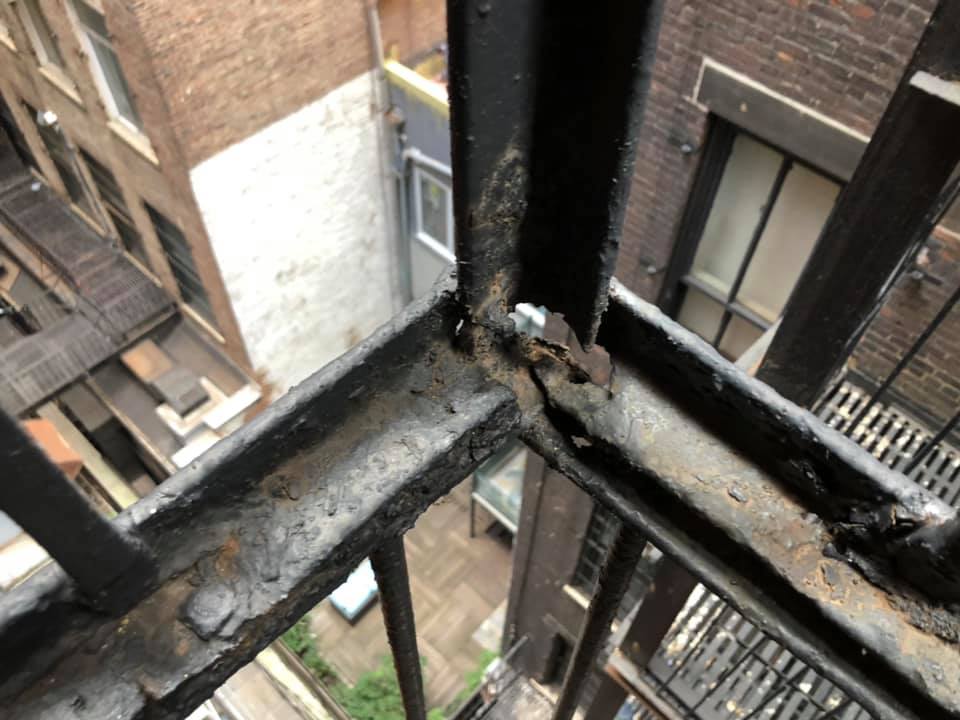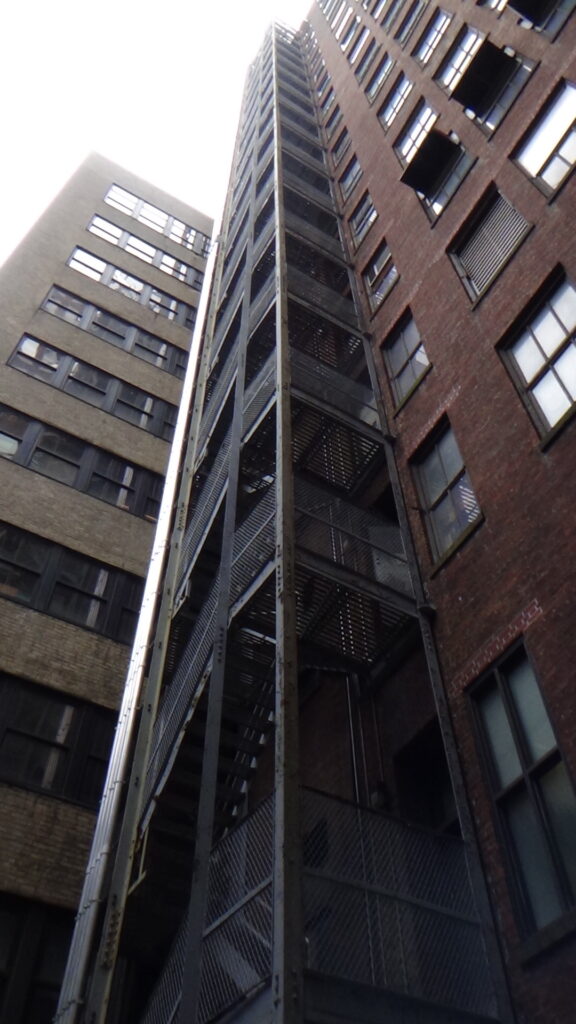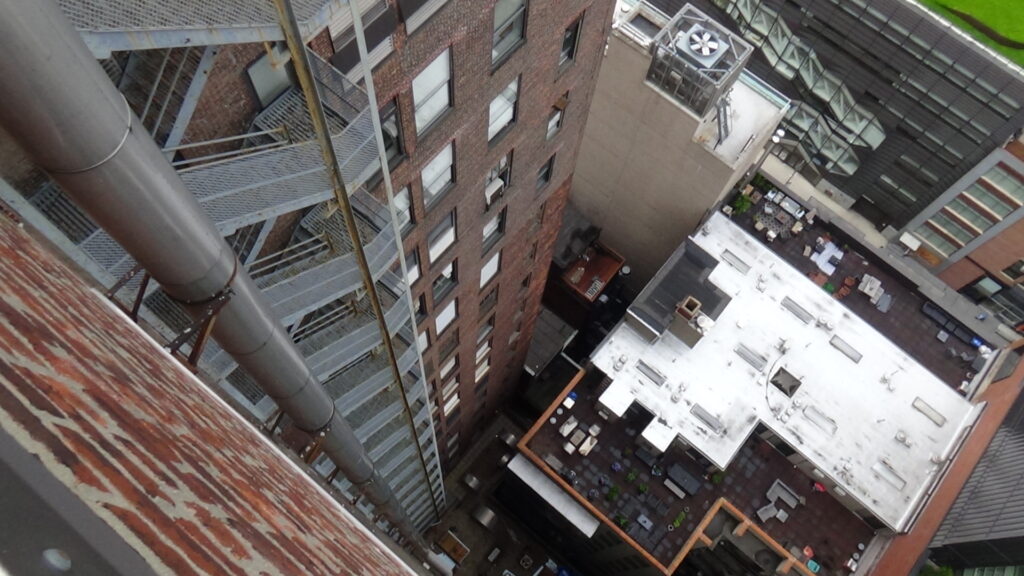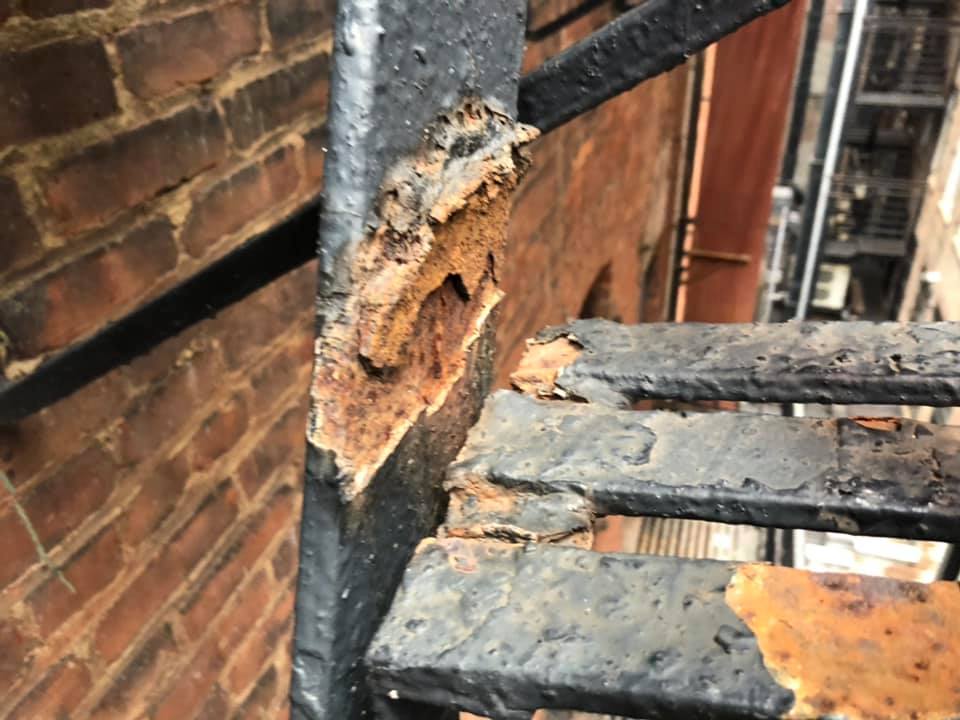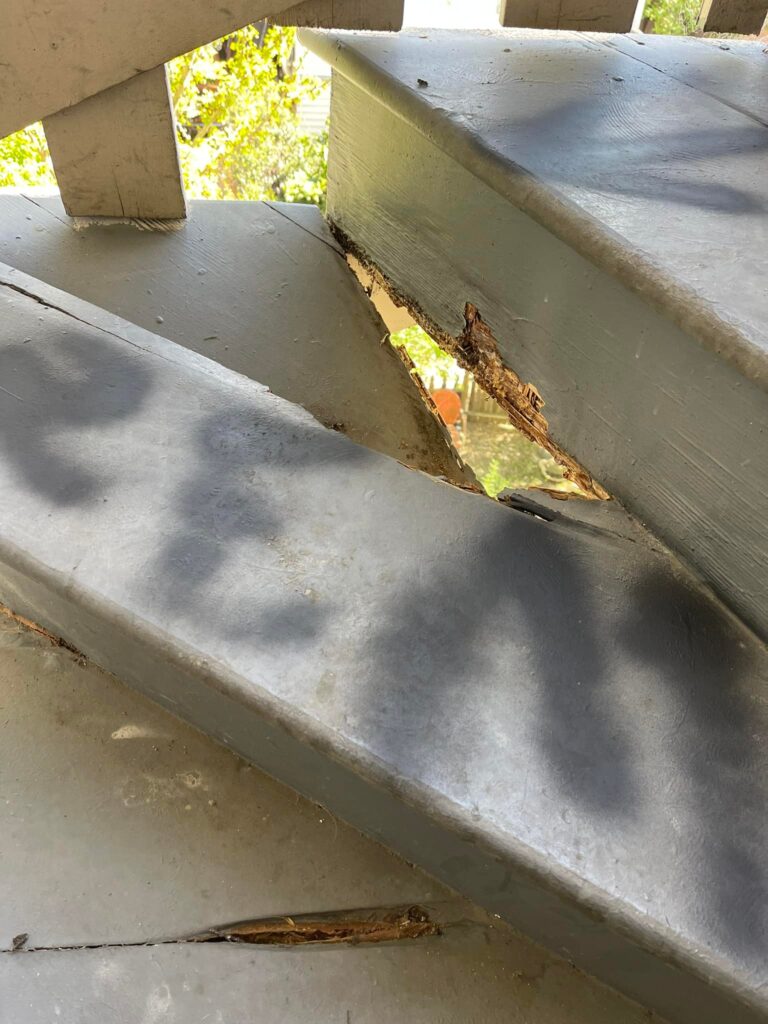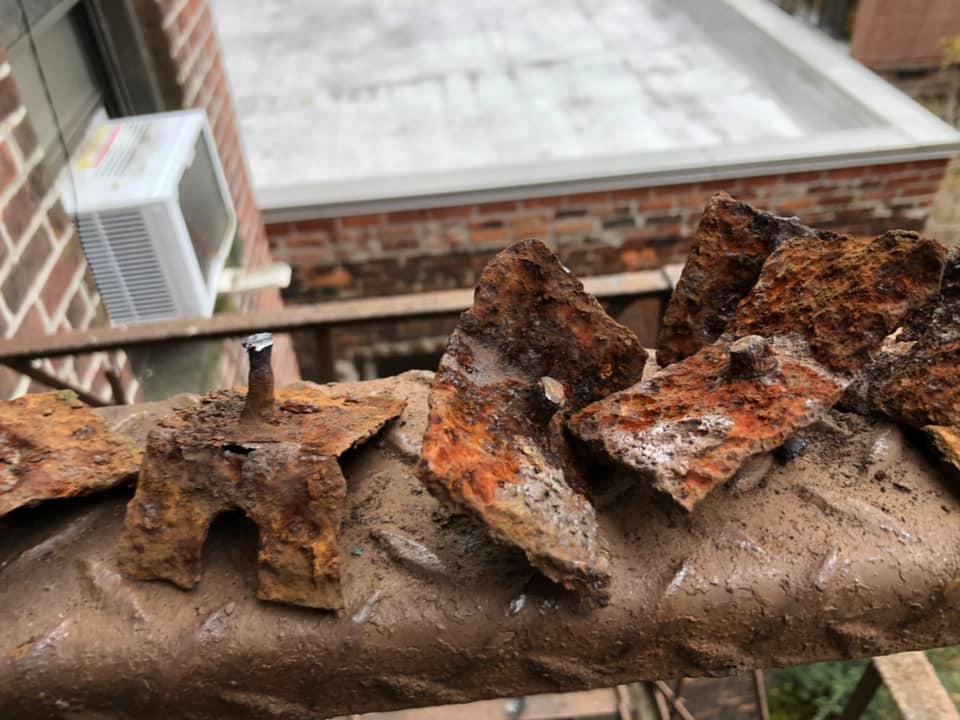OTHER EGRESSES AND EXTERIOR STRUCTURES WE SERVICE
Ladders • Wood Staircases • Spiral Staircases • Balconies • Porches • Decks • Roof Decks • Ramps • Elevated WalkWays • Pedestrian Bridges • Guard Rails
STEPS to Certify a Fire Escape:
- Verify with your local official, the AHJ (Authority Having Jurisdiction), the requisite certification procedure for your jurisdiction. The NATIONAL code requires fire escapes be certified every five years.
- Schedule An Inspection or a Pre-Load Test Evaluation with Load Test
- Submit certification if the fire escape system passed. If the fire escape failed, submit Inspection/Deficiency Report to AHJ.
- Do repairs if required to certify. A Technical Repair Report is a Construction Control Document that is used for bidding by fire escape repair vendors. Vendor oversight is when the chosen vendor’s work is overseen by a Certified Fire Escape Engineer and then certifies the work to the AHJ. Vendors must be qualified with correct licenses and insurance to do fire escape repairs and cannot certify their own work.
- Certification by Load Test, Restoration (Other Evidence of Strength) or Repairs with disclaimer of liability.
Fire Escapes New York City
Click on link below for NYC Fire Escape Code Requirements:
§15-10 Fire-Escapes, Fire Stairs and Fire Towers. 1_RCNY_15-10
1) Local New York City LAW 11 requires Fire Escapes that are 7 stories and above to be inspected AND certified every 5 years.
2) New York State requires Fire Escapes to be inspected AND certified every 5 years.
Code Highlights
New York City is a vibrant metropolis because it’s made up of so many individual, vibrant neighborhoods. Updated in 2014, the New York City Fire Code is a City law that establishes fire safety requirements for buildings and businesses in New York City. It applies to all persons and places in New York City.
The Fire Code regulates such matters as emergency preparedness; the prevention and reporting of fires; the manufacture, storage, handling, use and transportation of hazardous materials and combustible materials; the conduct of various businesses and activities that pose fire hazards; and the design, installation, operation and maintenance of the buildings and premises that house such materials, businesses and activities.
The Fire Department implements the New York City Fire Code by adopting rules. A rule is an agency regulation that has the force of law. All of the Fire Department rules are compiled in Title 3 of the Rules of the City of New York. Before any Fire Department Rule is adopted, it is posted on the NYC Rules website, and the public is given an opportunity to review it and submit comments. The Fire Department also conducts a public hearing at Fire Department Headquarters. Final Department rules are published by NYC Rules, and generally take effect 30 days after publication
- Get Fire Department Rules(PDF) (Published 10/01/2017)
http://www1.nyc.gov/assets/fdny/downloads/pdf/business/nyc-fire-code-guide.pdf
Fire escapes are addressed in the following chapters and sections of the New York
Chapter 10 Means of Egress
Chapter 14 Fire Safety During Construction, Alteration & Demolition
Chapter 10, Section FC 1025 Emergency Escape and Rescue.
FC 1025.4 Operational constraints. Emergency escape and rescue openings and windows or other openings onto fire escapes, as that term is defined in the New York State Multiple Dwelling Law, shall be operational from the inside of the room without the use of keys or tools. Bars, grilles, grates or similar devices are allowed to be placed over emergency escape and rescue openings and windows or other openings onto fire escapes, provided the minimum net clear opening size complies with the requirements of the construction codes, including the Building Code and the New York State Multiple Dwelling Law, and such devices are releasable or removable from inside of the room without the use of a key, tool or force greater than that which is required for normal operation of the escape and rescue opening, window or other opening.
1025.5 Certificate of approval. Bars, grilles, grates or similar devices placed over emergency escape and rescue openings, and windows or other openings onto fire escapes, shall be of a type for which a certificate of approval has been issued in accordance with this code and the rules.
FC 1027 Maintenance of the Means of Egress.
1027.1 General. The means of egress for buildings, structures or premises, or parts thereof, shall be maintained in accordance with the construction codes, including the Building Code and this section.
1027.2 Prohibition. It shall be unlawful to obstruct or impede access to any required means of egress, including any exit, exit access or exit discharge.
FAQ:
FC1027.2 prohibits obstructing any means of egress. This includes any building fire escape. Fire Department rule 3 RCNY §404-03(d) specifically provides that awnings, canopies, decorations and umbrellas shall not obstruct or otherwise impede use of a fire escape ladder.
Sidewalk cafes that are located in areas where building fire escapes provide egress to the street level must be designed and maintained in a manner that does not impede the operation of the fire escape ladder or obstruct egress from the ladder.
Most fire escapes are equipped with a drop ladder that is lowered vertically to the sidewalk. Some fire escapes are equipped with a counterbalanced stair ladder, in which a large section of fire escape containing stairs swings to the ground.
The following guidelines are intended to provide general guidance with respect to clearances. These guidelines do not preclude the Fire Department from imposing additional or different requirements depending on specific site conditions.
Guidelines for Sidewalk Cafes:
- An awning is prohibited underneath any fire escape ladder, unless the awning has a minimum 3-foot by 3-foot opening that allows for passage down the fire escape ladder through the awning, or is equipped with a hatch that is readily openable by operation of the fire escape ladder.
- Fixed furniture, table umbrellas or other fixtures are prohibited underneath any fire escape drop ladder. Readily movable tables, chairs and other furnishings are acceptable underneath a fire escape drop ladder.
- Cafe heaters are prohibited underneath any fire escape drop ladder. A minimum distance of 4 feet is acceptable. Cafe heaters shall be installed in accordance with the provisions of the Fire Code and New York City Department of Buildings Technical Policy and Procedure Notice 2-2007.
- All sidewalk cafe fences or planters on the sidewalk alongside any part of a fire escape must be readily movable. Any fixed or heavy fences or planters must be approved by the Fire Department. This is to ensure that portable ladders can be used to access the fire escape. Requests for such approval shall be directed to the Bureau of Operations, New York City Fire Department, 9 MetroTech Center, Brooklyn, NY 11201.
- The entire area underneath a counterbalanced stair fire escape ladder must be kept clear of awnings, canopies, furniture, cafe heaters and other furnishings and fixtures. The presence of furniture and fixtures could impede the proper functioning of the fire escape and/or injure any persons sitting or standing underneath the fire escape.
1027.3 Unobstructed and unimpeded egress required. All required means of egress, including each exit, exit access and exit discharge, shall be continuously maintained free from obstructions and impediments to immediate use in the event of fire or other emergency.
1027.3.1 Door hardware. Door hardware and other devices and physical components of the means of egress shall be maintained in good working order at all times
1027.3.7 Fire Escapes. Access to fire escapes shall be maintained in accordance with FC 1027.6.
1027.6 Fire escapes. Fire escapes, and access thereto, shall be maintained in a safe and operational condition, and continuously maintained free from obstructions and impediments to immediate use in the event of fire or other emergency.
1027.6.1 Maintenance. All fire escape components shall be painted or otherwise protected from deterioration and all moving parts shall be maintained in good working order.
1027.6.2 Window gates. Bars, grilles, grates or similar devices placed over windows or other openings onto fire escapes shall be maintained in good working order.
1027.6.3 Air conditioners. An air conditioner shall not be installed in a window providing access to a fire escape unless such fire escape may be accessed from another window in the same room that is unobstructed and of the size required for such purpose by the Building Code, New York State Multiple Dwelling Law, or other applicable law, rule or regulation. Air conditioners installed in windows adjoining fire escapes shall not obstruct the path of egress on the fire escape.
1027.6.4 Fire escape ladders. The operation of a fire escape ladder, including a drop ladder that is lowered vertically to the ground, or a counterbalanced stair ladder which swings to the ground, shall not be obstructed by awnings, stationary furniture, portable fueled space heaters, parked cars, or other obstructions. Where construction work is being performed at a location adjoining a fire escape, provision shall be made for safe egress from the fire escape ladder.
1027.7 Non-exit door identification. Any door that is not an exit or otherwise part of the means of egress from a building, structure or premises, but which, by reason of its proximity or similar construction, can be confused with an exit door or other door that is part of the means of egress, shall be identified with an approved sign that reads “Not An Exit” and identifies the room into which the non-exit door provides access.
Violations
An FDNY violation is an official notice that a property is not in compliance with the New York City Fire Code and/or Fire Department Rules. Some infractions are minor, while others can create dangerous situations resulting in immediate action by the Fire Department or even the issuance of a criminal summons. Violations can be found during an FDNY inspection or based on complaints to the City. The following types of violations are issued/ordered in New York City: Notice of Violation, Violation Order, Criminal Summonses and a Vacate Order.
To remove a violation from record, the unsafe condition must be corrected and proof of the correction must be provided to the FDNY. After correcting the condition, a Certificate of Correction must be completed within 35 days from the day the violation originally was issued. Locations where a Vacate Order was issued must be re-inspected to complete the correction process.
Request a Copy of Violation
The FDNY can provide copies of violations. To ensure quick delivery, be sure to complete the Copy of Violation Request Form and attach all required documents. Please note, Vacate Orders can be obtained only in person. For additional information or questions, contact the Fire Department.
Inspections
The FDNY conducts inspections that examine buildings, structures, facilities, vehicles and other locations in New York City. The purpose of an inspection is to ensure that code, laws, rules or regulations are being enforced to keep the public safe.
The owner shall be responsible, at all times, for the safe maintenance of any building, structure and/or premises and make sure it is kept up to code. Anything that needs to be fixed is the responsibility of the owner. Sometimes, when the tenant of a space in the building causes the hazardous condition in violation of the code or rules, the tenant is responsible to resolve the issues.
Request an Inspection or an On-Site Test
There are a number of ways to request an inspection or an On-Site Test.
Other areas where the New York City fire escape code may apply is the following:
| Queens (QN) Communities: |
| Northeast Queens Auburndale (CB 11), Bay Terrace (CB 7), Bayside (CB 11), Bellerose (CB 13), College Point (CB 7), Douglaston (CB 11), Floral Park (CB 13), Flushing (CB 7), Fresh Meadows (CB 8), Glen Oaks (CB 13), Jamaica Estates (CB 8), Jamaica Hills (CB 8), Little Neck (CB 11), Malba (CB 7), Oakland Gardens (CB 11), Queensboro Hill (CB 7), Whitestone (CB 7)Northwest Queens Astoria (CB 1), Astoria Heights (CB 1), Corona (CB 4), East Elmhurst (CB 3), Elmhurst (CB 4), Jackson Heights (CB 3), LeFrak City (CB 4), Long Island City (CB 1 / CB 2), Sunnyside (CB 2), Woodside (CB 1 / CB 2)Central Queens Briarwood (CB 9), Forest Hills (CB 6), Forest Hills Gardens (CB 6), Kew Gardens (CB 9), Kew Gardens Hills (CB 8), Rego Park (CB 6), Richmond Hill (CB 9)Southeast Queens Cambria Heights (CB 13), Hollis (CB 12), Jamaica (CB 12), Laurelton (CB 13), Queens Village (CB 13), Rosedale (CB 13), Springfield Gardens (CB 12), St. Albans (CB 12)Southwest Queens Glendale (CB 5), Maspeth (CB 5), Middle Village (CB 5), Ridgewood (CB 5), Woodhaven (CB 9)South Queens Belle Harbor (CB 14), Broad Channel (CB 14), Far Rockaway (CB 14), Howard Beach (CB 10), Ozone Park (CB 9 / CB 10), South Ozone Park (CB 10) |
Added on Twitter: NYC Mayor’s Community Affairs Unit @mayorsCAU
The Mayor’s Community Affairs Unit connects NYC neighborhoods & New Yorkers to City Hall.
Key AHJ’s:
- New York Fire Commissioner Daniel Nigro http://www1.nyc.gov/site/fdny/about/overview/leadership/fire-commissioner.page
Fire Hazard Complaint
You can report potential fire hazards. Reports of situations that may cause a fire hazard, include:
- Unmaintained fire escapes
- Leaking sprinkler or standpipe systems
- Missing exit signs
- Lack of secondary exit
- Storage of paints or other combustible mixture
- Illegal kerosene or propane grills and heaters
The City will issue summonses and violations when appropriate.
Download the Fire Hazard Complaint form (PDF).
NYC Residential Code:
1 RCNY§103-04 CHAPTER 100 Subchapter C Maintenance of Buildings
http://www1.nyc.gov/assets/buildings/rules/1_RCNY_103-04.pdf
NYC Lead Paint Repair Grant for Landlords
The City may provide grants to help eligible landlords fix lead paint hazards in their buildings. These grants cannot be used to fix violations or other work ordered by any city, state or federal agency. You can get information about program eligibility requirements and an application. Call 311 for information about lead paint repair grants.
Lead-Safe Renovation, Repair, and Painting
Information for Homeowners, Contractors, Landlords, and Tenants
Some renovation and remodeling activities can increase the risk of lead exposure. Homes built before 1978 contain lead-based paint, often under newer paint. If you disturb the painted surface with a repair project or are planning to renovate or remodel an older home, it’s important to do the job safely. Lead paint dust or chips can cause serious health problems. Children and pregnant women are at highest risk.
Seal off the work area with plastic sheeting and always wet sand or wet scrape the paint. When surfaces are wet, dust levels and fumes are low. Clean up thoroughly. Children and pregnant women should stay away from work areas until the area is clean.
Learn more about how to do repairs and renovations in a lead-safe way with the materials below.
Reducing Lead Hazards During Remodeling
- Tips for Contractors
- What You Need to Know About Working with Lead-Based Paint
- Encapsulants: A Technique to Control Lead Paint Hazards
- Contractors: Lead Safety During Renovation (EPA)
- Renovate Right: Important Lead Hazard Information for Families, Child Care Providers, and Schools (EPA)
- Small Entity Compliance Guide to Renovate Right (EPA)
- RRP: Renovation, Repair and Painting Rule (EPA)
Additional Information
- For additional questions email ceheduc@health.ny.gov
- Lead Hotline – The National Lead Information Center
- Maintenance requirements: Lead-based Paint http://www1.nyc.gov/site/hpd/owners/Lead-Based-Paint.page https://www1.nyc.gov/assets/doh/downloads/pdf/lead/lead-paint-fix-bro.pdf
N.Y. Labor Law 273 – excerpt:
7. Every fire-escape if constructed of material subject to rusting shall be painted with two or more coats of good paint in contrasting colors; in the case of a new fire-escape the first coat before erection, and the second coat after erection. Whenever a fire-escape becomes rusty, the owner shall repaint it with two additional coats of good paint. 8. a. Whenever a non-fireproof multiple dwelling is not provided with sufficient means of egress in case of fire, the department may order such additional fire-escapes or balconies as in its judgment may be deemed necessary. b. The owner of a multiple dwelling shall keep and maintain every fire-escape thereon in good order and repair. c. No person shall at any time place any encumbrance of any kind before or upon any fire-escape, or place or keep a cover of any kind over the stairway opening in a balcony of such fire-escape. An occupant or tenant of a multiple dwelling who shall violate or assist in the violation of the provisions of this paragraph shall be guilty of a misdemeanor punishable as provided in section three hundred four. 9. No fire-escape shall be removed from or constructed on any existing multiple dwelling without permission from the department. No fire-escape shall be removed from any apartment without due precaution against leaving occupants of such apartment without adequate means of egress in case of fire. A wire, chain cable, vertical ladder or rope fire-escape is an unlawful means of egress. Every such fire-escape, if required as a means of egress, shall be removed and replaced by a system of fire-escapes constructed and arranged as provided in this section. 10. The department shall have the power to make supplementary regulations relating to fire-escapes.
Send us photos of your fire escape by email: info@FireEscapeInspectors.com
NATIONAL CODES
2012 IFC 1104.16.5.1 Fire escape stairs must be examined every 5 years ,by design professional or others acceptable and inspection report must be submitted to the fire code official.
IBC 1001.3.3 All fire escapes shall be examined and/or tested and certified every five years by a design professional or others acceptable who will then submit an affidavit city official.
NFPA LIFE SAFETY CODE 101 7.2.8.6.2 The Authority Having Jurisdiction (AHJ) shall approve any fire escape by Load Test or other evidence of strength (Certification).
OSHA 1910.37 Exit routes must be maintained during construction, repairs, alterations or provide alternative egress with equivalent level of safety. (permit issued if egress is certified or with egress scaffolding)

